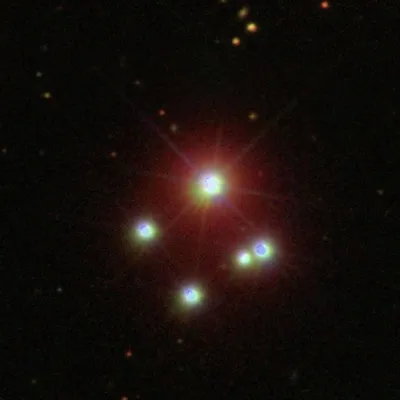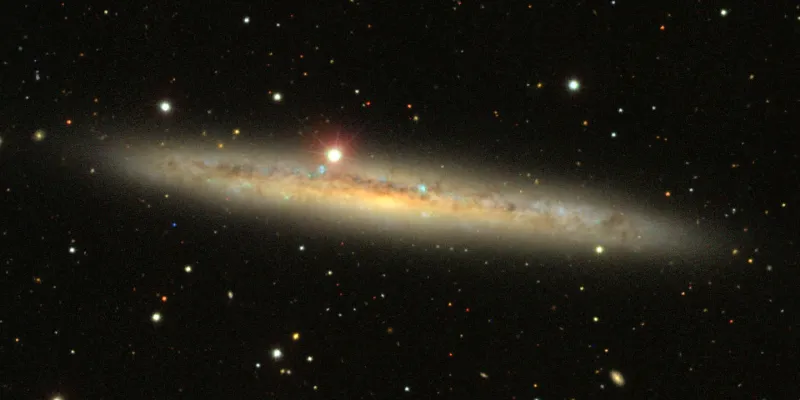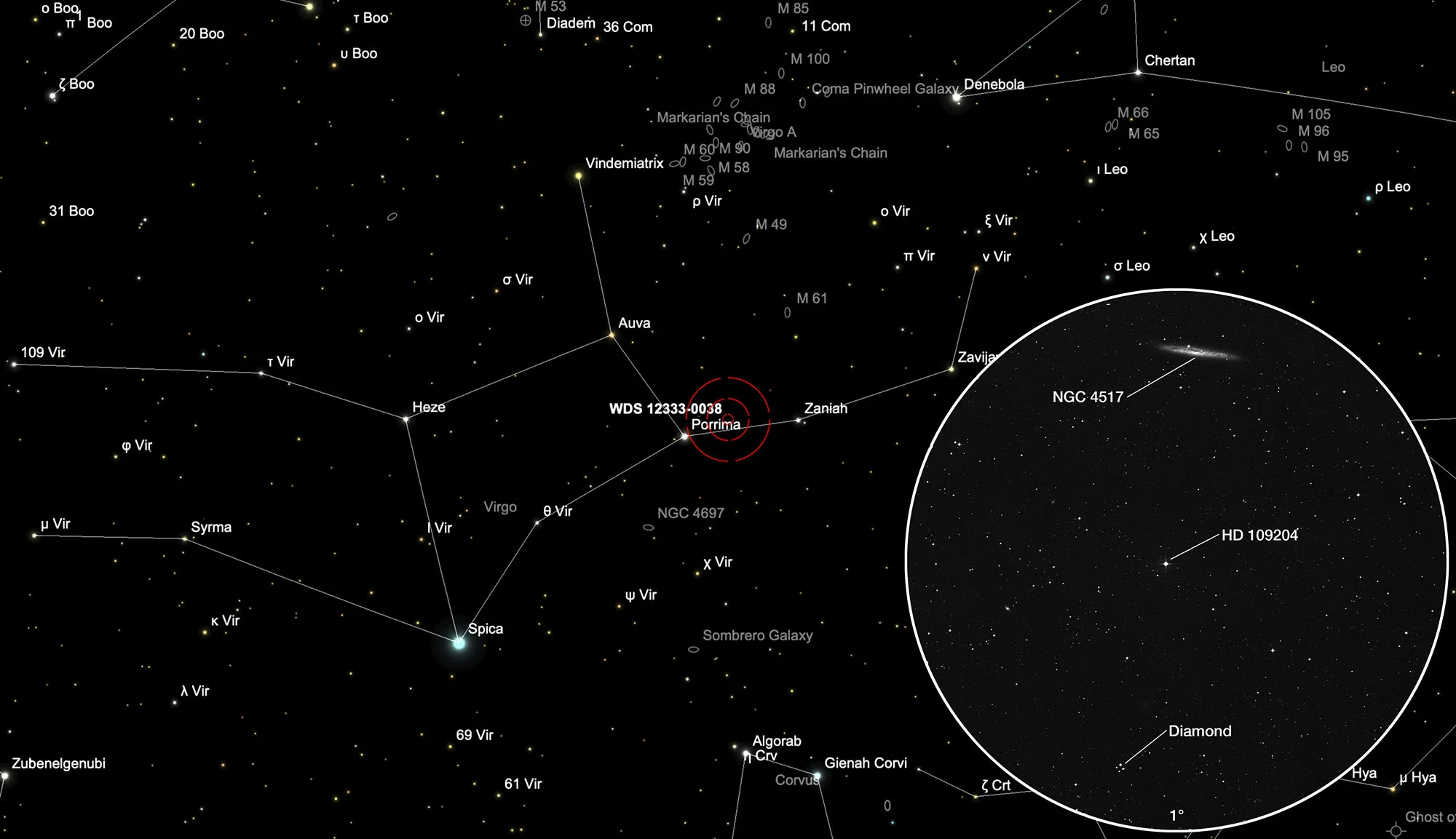Diamond with Galaxy NGC 4517
Object Description

In the December 1991 issue of Monthly Notices, published by the Royal Astronomical Society, Noah Brosch of Tel Aviv University, Israel, presented his study of a recently discovered group of stars in the Virgo constellation:
Five stars of around 13 mag and brighter form a diamond-shaped group with an edge length of only 42 arc seconds. The northern star is TYC 4948-53-1 and has a magnitude in the V-band of 10.8 mag. Its distance is 241 pc (786 ly) and it is moving at 6 km/s in our direction. (Gaia DR2) [145] The western star of this group is a close binary star. There is little chance that five stars of roughly the same brightness will happen to appear so close together. Brosch suspects that the stars of the "diamond" (as he is nicknamed) also interact physically with one another. [101]
| Name | TYC 4948-53-1 |
| Object Type | Star |
| Right Ascension (J2000.0) | 12h 33m 19s |
| Declination (J2000.0) | +00° 38' 32" |
| Parallaxes | 4.1389 mas |
| Radial velocity | -6.01 km/s |
| Redshift z | -0.00002 |
| Magnitudes | B 11.3; V 10.8; G 10.874996; J 9.923; H 9.626; K 9.543 |
| Identifiers | 2MASS J12331896-0038324; GSC 04948-00053; Gaia DR1 3695707345461359488; Gaia DR2 3695707349757553280; Gaia DR3 3695707349757553280; TIC 130639932; TYC 4948-53-1 |
Galaxy NGC 4517

This edge-on galaxy was discovered by William Herschel on February 22, 1784 and noted in his classification scheme as IV 5. Herschel's class IV stood for planetary nebulae but also «stars with burs, with milky chevelure, with short rays, remarkable shapes, etc.». He noted: "A pretty bright star with a milky ray south parallel and 15 or 20' long.» [463] Später erhielt diese Galaxie die Bezeichnung NGC 4517 von John L. E. Dreyer in seinem 1888 erschienenen «New General Catalogue of Nebulae and Clusters of Stars». [313]
On April 14, 1828, the galaxy was discovered again by his son John (h 1277, GC 2996) and was then given the number NGC 4437. According to Dreyer, the description of NGC 4437 is as follows: «faint, extremely extended 75°, 10th magnitude star to the northeast, place is that of the star». But there is nothing at the listed position. According to Corwin, the answer to the problem was suggested by Reinmuth and then confirmed by Dorothy Carlson in her NGC correction list of 1940: The description of the nebula and star exactly matched NGC 4517, which is five minutes further east. Unfortunately, due to a typo (4517 to 4417) in Carlson's list, NGC 4437 was long equated with NGC 4417. Since Corwin pointed out the bug, the identification of NGC 4437 as NGC 4517 has been certain. Today the designation NG 4517 is common. [196]
Distance measurements from NGC 4517 vary from 8.3 Mpc to 17.3 Mpc (27.1 to 56.4 million light years). [145]
| Name | RA | Dec | Type | bMag | vMag | B-V | SB | Dim | PA | z | D(z) | MD | Dreyer Description | Identification, Remarks |
|---|---|---|---|---|---|---|---|---|---|---|---|---|---|---|
| NGC 4517 | 12 32 45.6 | +00 06 56 | Gx (Sc) | 11.1 | 10.4 | 0.7 | 13.2 | 10.5 × 1.5 | 83 | 0.003764 | 15.90 | 9.760 | cB, vL, vmE 89°, pB * in cont | WH IV 5; GC 3066; NGC 4437; UGC 7694; MCG 0-32-20; IRAS 12301+0023; FGC 1455; CGCG 14-63; UM 505; KCPG 344B |
| NGC 4517 A | 12 32 28.1 | +00 23 25 | Gx (SBdm) | 12.9 | 12.5 | 0.4 | 14.9 | 4 × 2.6 | 30 | 0.005032 | 21.25 | 22.680 | cB, vL, vmE 89°, pB * in cont | WH IV 5; GC 3066; UGC 7685; MCG 0-32-19; CGCG 14-62; Reinmuth 80; KCPG 344A |
Where can you find a Diamond?
You will look for this small group of stars in vain in most atlases, which is why you have to rely on this map here. It is best to start with the search at the edge-on galaxy NGC 4517. There you can reach the diamond via the 8.31 mag bright star HD 109204 about 0.8 ° in a southerly direction. On 30 March it is in opposition to the Sun and crosses the meridian at local midnight.
Visual Observation
320 mm Aperture: The star formation named Diamond appears with four stars arranged in a precise square shape. — 12.5" Ninja-Dobson F:4.5, Glaubenberg, 2. 4. 2005, Durchsicht ca. 6.7m, Eduard von Bergen
